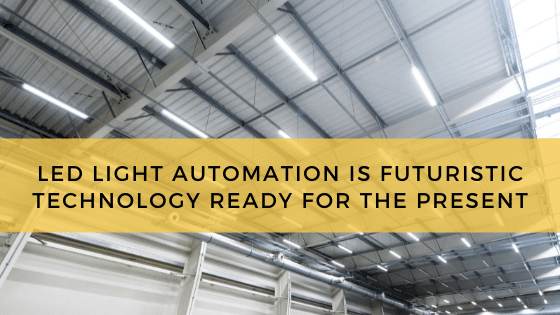
Although home automation technology has been around for decades, only recently has LED light automation become a viable solution for all home and business owners. LED engineering has improved greatly in just the last 10 years and many of the technologies required for effective lighting automation have also improved.
That’s great news for people seeking better efficiency and performance from their lighting solution. With LED light automation it’s possible to achieve new heights in energy savings, occupant comfort and security.
What Are Some Effective LED Light Automation Products?
One of LED lighting’s many benefits is its controllability. No other lighting technology can be controlled as easily or with as much versatility as LED lighting. This extends to full LED lighting automation, as your LED fixtures can be controlled using the following automation technologies:
Timers
Timers are used to define when the light’s settings should change. This could be a change in output level or when the light is switched on or off.
Occupancy Sensors
Occupancy sensors detect when people are in the immediate area and switch the lights on in response. They also switch the lights off when the area is clear. Most occupancy sensors rely on motion to work, though some can also detect heat.
Photocells
Photocells are essentially light sensors. When they detect light, they react. When used with LED lighting, photocells can be used to switch the fixtures off when ambient light is present and switch them on when ambient light is absent.
Dimmers
Dimmers can be used to make precise adjustments to the lamp’s output. Dimmers come in many forms, from tactile control knobs to programmable solutions that bring the lights up or down at predetermined times.
Color Controls
Unlike other forms of lighting LED lights can output a full spectrum of colors depending on the chemical substrate that powers the LED’s semiconductor. With automated color controls users can specify what colors to display at any given time.
LED Light Settings Can Be Programmed In Advance
LED light automation isn’t just effective, it’s convenient. As the term suggests light automation technology is designed to run with minimal input. Once you’ve determined what your lighting controls should be set at those preferences just need to be programmed in. Set dates, times and your lighting’s configuration and the system handles the rest.
Modern lighting controls can even be programmed from your own device. This greatly simplifies management and is particularly useful for people responsible for managing a lot of LED lighting at once.
What Are The Benefits Of Automating An LED Lighting System?
Home automation has always promised compelling benefits for those willing to invest in the technology, but the technology has only become viable recently. Now that lighting automation solutions are now feasible for home and business owners there’s a lot to like about the technology. For example, with LED lighting automation you can look forward to the following:
Enhanced System Efficiency
Lighting is a primary energy expenditure for homes and businesses alike. If that lighting is on when people don’t need it, it’s a waste. Lighting automation technology ensures that your LED lighting is only on when people are present, minimizing waste and operating costs.
Improved Security
LED lighting automation can be used to switch the lights on when they are needed most for security purposes—at night. Photocells switch the lamps on when the sun is down. Timers can fill the same role. Motion sensors detect when potential intruders are nearby and switch the lights on as a warning. Lighting automation technology can also be used to power all the building’s lights on at once when someone is trespassing, and this can help law enforcement quickly respond to a potential break-in.
Reduced Maintenance And Manpower Needs
LED lighting automation extends each lamp’s life by powering them down when they aren’t needed. LED lighting already exhibits an impressive lifespan, but lighting automation enhances this and further reduces maintenance costs. Automation technology is also set-and-forget by design, so your LED lighting will require minimal babysitting once automation is in place.
Improved Lighting Performance And Aesthetics
No other lighting technology can be controlled as well as LED, down to the aesthetic level. With color controls, for example, users can change the lighting’s appearance in one room while leaving another room untouched. With dimmers, users can set their LED lights to slowly come up in the morning or slowly taper off in the evening for comfort or aesthetic reasons.
Compliance With Local Lighting Ordinances
LED lighting automation is also an effective solution for exterior applications, such as neighborhood parks and parking lots. Excess light pollution can be a problem for these settings, but automated lighting controls keep it under control. To keep nearby neighbors happy a neighborhood park could tie its LED lighting to timers that switch off when the park is closed. Dimmers, photocells and occupancy controls can also be used to control light spill in this way.
LED Lighting Automation Is A Wise Investment For Residential And Commercial Buildings
Automating your LED lighting will provide a compelling array of benefits—the kind of benefits that a residential or commercial property could benefit from.
In an office, LED light automation reduces waste and provides optimal illumination for productivity. In a warehouse or industrial facility LED light automation enhances security and safety with better color rendering and lighting performance. At the park LED light automation minimizes light pollution and ensures the park remains a good neighbor.
In the home LED light automation can do it all—reduce energy expenditures, ward off potential intruders, minimize lamp replacement and provide the kind of light that people are happy with.
That means LED light automation is no longer a far off, futuristic fantasy. Instead, it’s a viable present-day option for any home or business owner that wants more from their lighting solutions.






